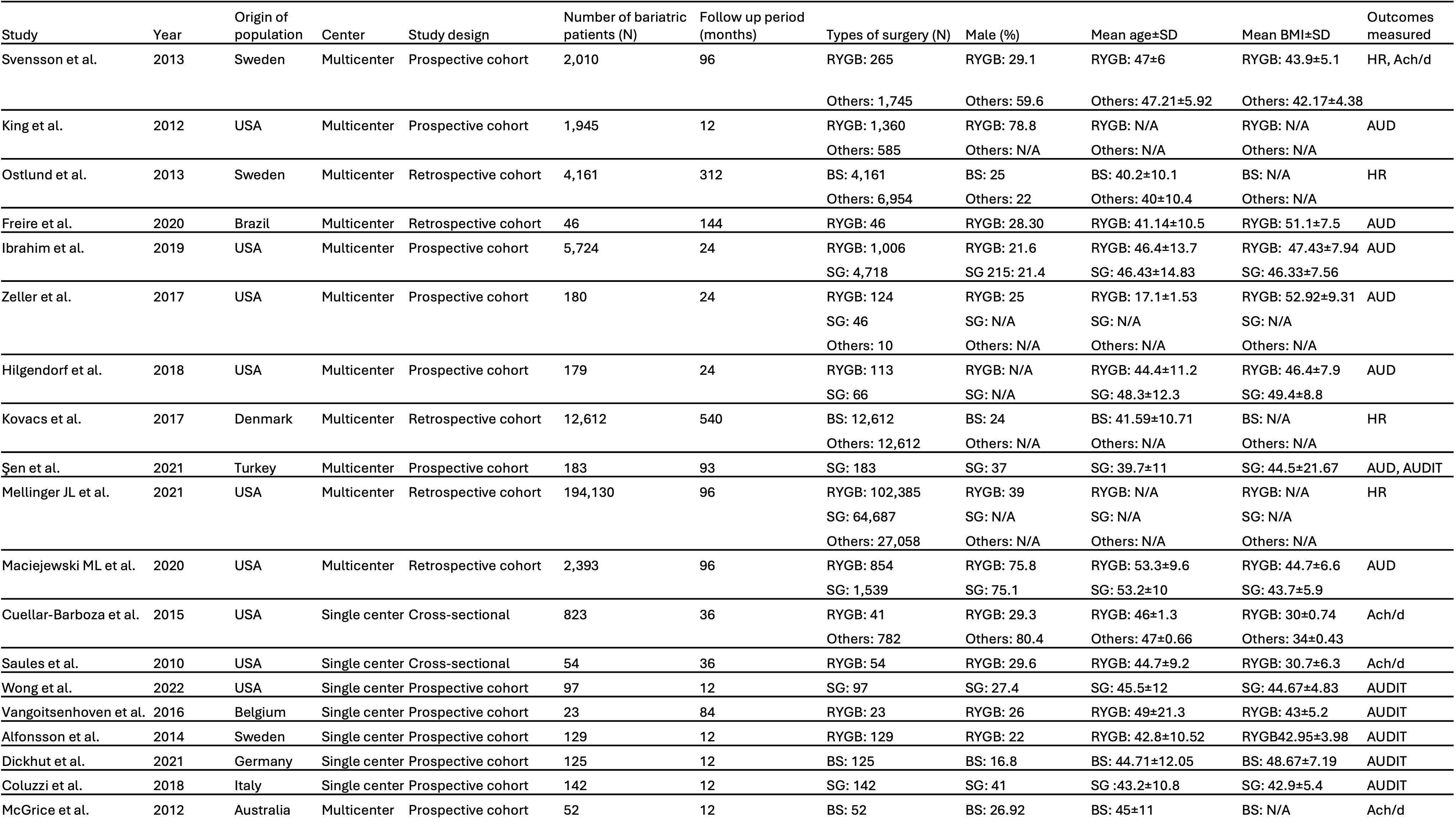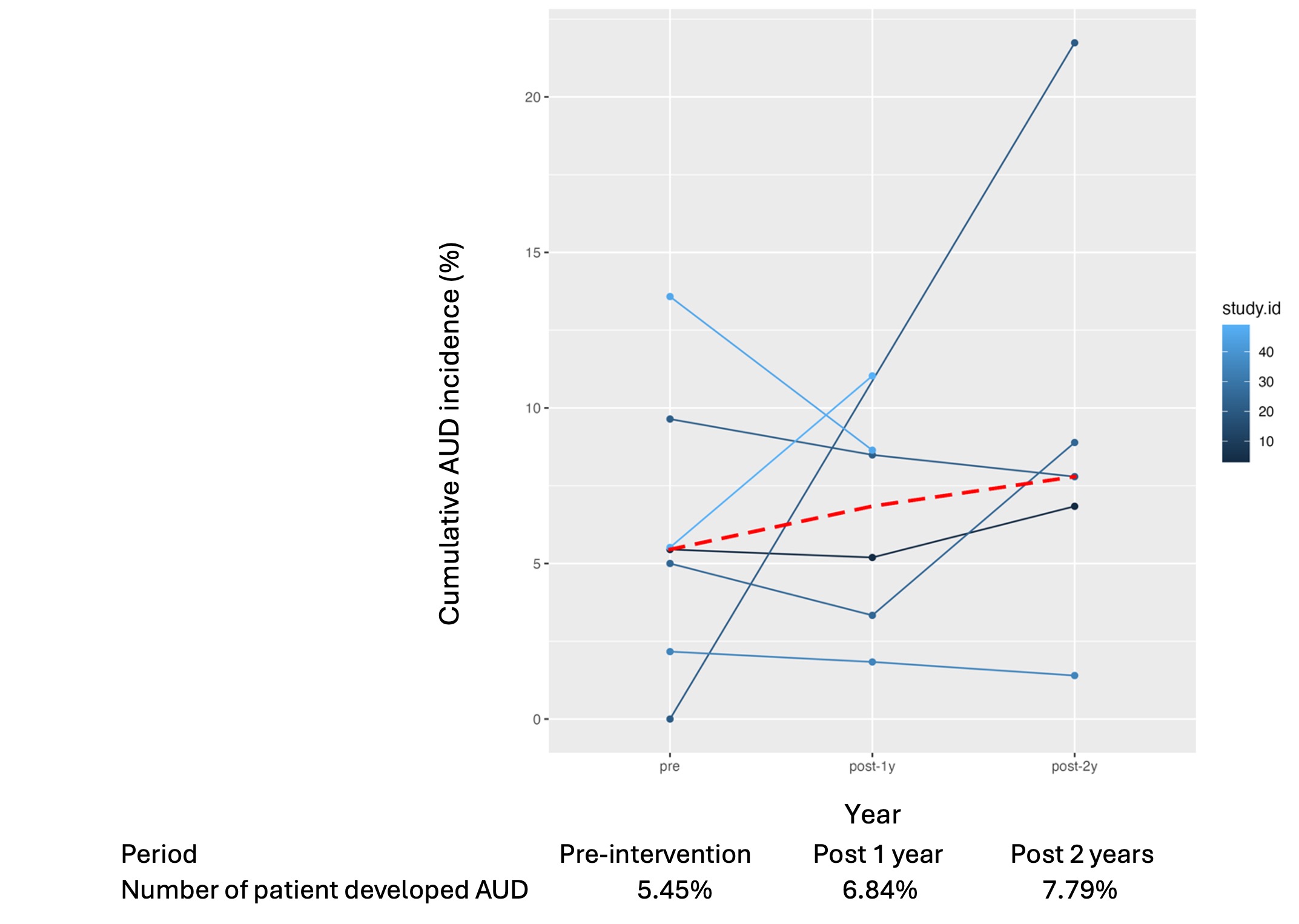Sunday Poster Session
Category: Diet, Nutrition, and Obesity
P0541 - Alcohol-Related Outcomes in Patients with Obesity Underwent Bariatric Surgery: A Systematic Review and Meta-Analysis
Sunday, October 26, 2025
3:30 PM - 7:00 PM PDT
Location: Exhibit Hall

Rinrada Worapongpaiboon, MD
Johns Hopkins University School of Medicine
Baltimore, MD
Presenting Author(s)
Rinrada Worapongpaiboon, MD1, Patavee Pajareya, MD2, Somkiat Phutinart, MD2, Karan Srisurapanont, MD1, Paphawee Chiarakiat, 2, Nithit Singtokum, MD2, Sireenada Sattawatthamrong, MD2, Pojsakorn Danpanichkul, MD3, Thanathip Suenghataiphorn, MD4, Natchaya Polpichai, MD5, Panisara Fangsaard, MD6, Chawin Lopimpisuth, MD7, Noppachai Siranart, MD8
1Johns Hopkins University School of Medicine, Baltimore, MD; 2King Chulalongkorn Memorial Hospital, Bangkok, Krung Thep, Thailand; 3Department of Internal Medicine, Texas Tech University Healt, Lubbock, TX; 4Griffin Hospital, Derby, CT; 5Division of gastroenterology/hepatology, Medical College of Georgia at Augusta University, Chicago, IL; 6Bassett Medical Center, Cooperstown, NY; 7University of Miami Miller School of Medicine at Jackson Memorial Hospital, Miami, FL; 8Brigham and Women's Hospital, Harvard Medical School, Boston, MA
Introduction:
Obese patients undergoing bariatric surgery (BS) may experience an increase in alcohol consumption. However, evidence regarding alcohol-related outcomes following BS remains limited. This study aims to assess alcohol-related outcomes in the obese population who have undergone BS.
Methods:
Electronic searches were performed up to November 2024 focusing on studies reporting alcohol-related outcomes after BS. The control group was obese patients not receiving BS. Primary endpoint was the incidence of alcohol use disorder (AUD) before and at 1-year and 2-year after BS. Secondary endpoints were the alcohol use disorder identification test (AUDIT) score change and the amount of alcohol intake in grams per day. We performed subgroup analyses according to the type of BS including Roux-en-Y Gastric Bypass (RYGB) and sleeve gastrectomy (SG). Data were analyzed using both random and common-effects models based on heterogeneity.
Results:
We analyzed data from 19 studies including 12 prospective cohort, 5 retrospective cohort and 2 cross-sectional studies totaled 225,008 bariatric patients. AUD incidence is significantly increased in BS group compared to the non-BS group with an HR of 2.81[95%CI 1.39-5.67, I2=88%, p< 0.01]. At 1-year post-BS, AUD incidence was at 5% [95%CI 3-11%, I2=98%, p< 0.01]. Subgroup analysis showed AUD incidence for RYGB and SG group were at 8% [95%CI 3-17%, I2=96%, p< 0.01] and 4% [95%CI 1-18%, I2=99%, p< 0.01], respectively. At 2- year post-BS, AUD incidence was at 7% [95%CI 2-19%, I2=98%, p< 0.01]. Subgroup analysis showed AUD incidence for RYGB and SG group were at 7% [95%CI 1-30%, I2=95%, p< 0.01] and 4% [95%CI 0-29%, I2=99%, p< 0.01], respectively. The AUDIT score did not significantly change between pre- and post-BS with mean differences of 0.23 [95%CI -1.37,1.83, I2=95%, p< 0.01]. The mean amount of 2-year post-BS alcohol intake was 29.58 grams per day [95%CI 1.08-812.18, I2=100%, p< 0.01].
Discussion:
The incidence of AUD has continuously risen following BS. It is crucial to enhance alcohol reduction strategies for the post-BS obese population in future guidelines.

Figure: Characteristics of the included studies. Ach/d: grams of alcohol intake per day, AUD: alcohol use disorder, AUDIT: alcohol use disorder identification test, HR: hazard ratio, BS: bariatric surgery, RYGB: Roux-en-Y Gastric Bypass, SG: sleeve gastrectomy, N/A: data not applicable.

Figure: Cumulative AUD incidence(%) of patients underwent bariatric surgery during 2-year post- operative period. Red dash line represented the mean cumulative AUD incidence(%) during each time point. The blue lines represented the cumulative AUD incidence(%) of each study labelled in the study ID bar. The number of patients developed AUD(%) at the following period at pre-intervention, 1-year post-intervention and 2-year post-intervention was presented in percentage below the figure.
Disclosures:
Rinrada Worapongpaiboon indicated no relevant financial relationships.
Patavee Pajareya indicated no relevant financial relationships.
Somkiat Phutinart indicated no relevant financial relationships.
Karan Srisurapanont indicated no relevant financial relationships.
Paphawee Chiarakiat indicated no relevant financial relationships.
Nithit Singtokum indicated no relevant financial relationships.
Sireenada Sattawatthamrong indicated no relevant financial relationships.
Pojsakorn Danpanichkul indicated no relevant financial relationships.
Thanathip Suenghataiphorn indicated no relevant financial relationships.
Natchaya Polpichai indicated no relevant financial relationships.
Panisara Fangsaard indicated no relevant financial relationships.
Chawin Lopimpisuth indicated no relevant financial relationships.
Noppachai Siranart indicated no relevant financial relationships.
Rinrada Worapongpaiboon, MD1, Patavee Pajareya, MD2, Somkiat Phutinart, MD2, Karan Srisurapanont, MD1, Paphawee Chiarakiat, 2, Nithit Singtokum, MD2, Sireenada Sattawatthamrong, MD2, Pojsakorn Danpanichkul, MD3, Thanathip Suenghataiphorn, MD4, Natchaya Polpichai, MD5, Panisara Fangsaard, MD6, Chawin Lopimpisuth, MD7, Noppachai Siranart, MD8. P0541 - Alcohol-Related Outcomes in Patients with Obesity Underwent Bariatric Surgery: A Systematic Review and Meta-Analysis, ACG 2025 Annual Scientific Meeting Abstracts. Phoenix, AZ: American College of Gastroenterology.
1Johns Hopkins University School of Medicine, Baltimore, MD; 2King Chulalongkorn Memorial Hospital, Bangkok, Krung Thep, Thailand; 3Department of Internal Medicine, Texas Tech University Healt, Lubbock, TX; 4Griffin Hospital, Derby, CT; 5Division of gastroenterology/hepatology, Medical College of Georgia at Augusta University, Chicago, IL; 6Bassett Medical Center, Cooperstown, NY; 7University of Miami Miller School of Medicine at Jackson Memorial Hospital, Miami, FL; 8Brigham and Women's Hospital, Harvard Medical School, Boston, MA
Introduction:
Obese patients undergoing bariatric surgery (BS) may experience an increase in alcohol consumption. However, evidence regarding alcohol-related outcomes following BS remains limited. This study aims to assess alcohol-related outcomes in the obese population who have undergone BS.
Methods:
Electronic searches were performed up to November 2024 focusing on studies reporting alcohol-related outcomes after BS. The control group was obese patients not receiving BS. Primary endpoint was the incidence of alcohol use disorder (AUD) before and at 1-year and 2-year after BS. Secondary endpoints were the alcohol use disorder identification test (AUDIT) score change and the amount of alcohol intake in grams per day. We performed subgroup analyses according to the type of BS including Roux-en-Y Gastric Bypass (RYGB) and sleeve gastrectomy (SG). Data were analyzed using both random and common-effects models based on heterogeneity.
Results:
We analyzed data from 19 studies including 12 prospective cohort, 5 retrospective cohort and 2 cross-sectional studies totaled 225,008 bariatric patients. AUD incidence is significantly increased in BS group compared to the non-BS group with an HR of 2.81[95%CI 1.39-5.67, I2=88%, p< 0.01]. At 1-year post-BS, AUD incidence was at 5% [95%CI 3-11%, I2=98%, p< 0.01]. Subgroup analysis showed AUD incidence for RYGB and SG group were at 8% [95%CI 3-17%, I2=96%, p< 0.01] and 4% [95%CI 1-18%, I2=99%, p< 0.01], respectively. At 2- year post-BS, AUD incidence was at 7% [95%CI 2-19%, I2=98%, p< 0.01]. Subgroup analysis showed AUD incidence for RYGB and SG group were at 7% [95%CI 1-30%, I2=95%, p< 0.01] and 4% [95%CI 0-29%, I2=99%, p< 0.01], respectively. The AUDIT score did not significantly change between pre- and post-BS with mean differences of 0.23 [95%CI -1.37,1.83, I2=95%, p< 0.01]. The mean amount of 2-year post-BS alcohol intake was 29.58 grams per day [95%CI 1.08-812.18, I2=100%, p< 0.01].
Discussion:
The incidence of AUD has continuously risen following BS. It is crucial to enhance alcohol reduction strategies for the post-BS obese population in future guidelines.

Figure: Characteristics of the included studies. Ach/d: grams of alcohol intake per day, AUD: alcohol use disorder, AUDIT: alcohol use disorder identification test, HR: hazard ratio, BS: bariatric surgery, RYGB: Roux-en-Y Gastric Bypass, SG: sleeve gastrectomy, N/A: data not applicable.

Figure: Cumulative AUD incidence(%) of patients underwent bariatric surgery during 2-year post- operative period. Red dash line represented the mean cumulative AUD incidence(%) during each time point. The blue lines represented the cumulative AUD incidence(%) of each study labelled in the study ID bar. The number of patients developed AUD(%) at the following period at pre-intervention, 1-year post-intervention and 2-year post-intervention was presented in percentage below the figure.
Disclosures:
Rinrada Worapongpaiboon indicated no relevant financial relationships.
Patavee Pajareya indicated no relevant financial relationships.
Somkiat Phutinart indicated no relevant financial relationships.
Karan Srisurapanont indicated no relevant financial relationships.
Paphawee Chiarakiat indicated no relevant financial relationships.
Nithit Singtokum indicated no relevant financial relationships.
Sireenada Sattawatthamrong indicated no relevant financial relationships.
Pojsakorn Danpanichkul indicated no relevant financial relationships.
Thanathip Suenghataiphorn indicated no relevant financial relationships.
Natchaya Polpichai indicated no relevant financial relationships.
Panisara Fangsaard indicated no relevant financial relationships.
Chawin Lopimpisuth indicated no relevant financial relationships.
Noppachai Siranart indicated no relevant financial relationships.
Rinrada Worapongpaiboon, MD1, Patavee Pajareya, MD2, Somkiat Phutinart, MD2, Karan Srisurapanont, MD1, Paphawee Chiarakiat, 2, Nithit Singtokum, MD2, Sireenada Sattawatthamrong, MD2, Pojsakorn Danpanichkul, MD3, Thanathip Suenghataiphorn, MD4, Natchaya Polpichai, MD5, Panisara Fangsaard, MD6, Chawin Lopimpisuth, MD7, Noppachai Siranart, MD8. P0541 - Alcohol-Related Outcomes in Patients with Obesity Underwent Bariatric Surgery: A Systematic Review and Meta-Analysis, ACG 2025 Annual Scientific Meeting Abstracts. Phoenix, AZ: American College of Gastroenterology.
